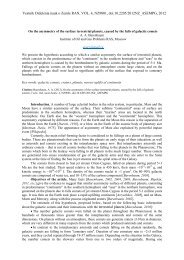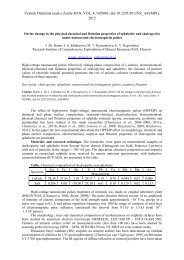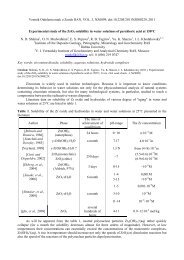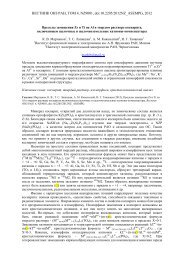Evaluation of thermodynamic properties of H4SiO4 in the ideal gas ...
Evaluation of thermodynamic properties of H4SiO4 in the ideal gas ...
Evaluation of thermodynamic properties of H4SiO4 in the ideal gas ...
You also want an ePaper? Increase the reach of your titles
YUMPU automatically turns print PDFs into web optimized ePapers that Google loves.
Vestnik Otdelenia nauk o Zemle RAN, VOL. 3, NZ6078, doi:10.2205/2011NZ000208, 2011<strong>Evaluation</strong> <strong>of</strong> <strong><strong>the</strong>rmodynamic</strong> <strong>properties</strong> <strong>of</strong> H 4 SiO 4 <strong>in</strong> <strong>the</strong> <strong>ideal</strong> <strong>gas</strong> state from experimental dataA. V. PlyasunovInstitute <strong>of</strong> Experimental M<strong>in</strong>eralogy RAS, Chernogolovkaplyasunov@iem.ac.ruKey words: H 4 SiO 4 , <strong><strong>the</strong>rmodynamic</strong> <strong>properties</strong>, <strong>ideal</strong> <strong>gas</strong> state.Citation: Plyasunov, A.V. (2011), <strong>Evaluation</strong> <strong>of</strong> <strong><strong>the</strong>rmodynamic</strong> <strong>properties</strong> <strong>of</strong> H 4 SiO 4 <strong>in</strong> <strong>the</strong> <strong>ideal</strong> <strong>gas</strong> state from experimental data,Vestn. Otd. nauk Zemle, 3, NZ6078, doi:10.2205/2011NZ000208.Thermodynamic <strong>properties</strong> <strong>of</strong> <strong>gas</strong>eous silicon hydroxides are necessary for analyz<strong>in</strong>g <strong>the</strong> silicatecondensation phenomena <strong>in</strong> <strong>the</strong> primordial solar nebula [Hashimoto, 1992], <strong>the</strong> silica precipitation <strong>in</strong> steam-richgeo<strong>the</strong>rmal systems and recent concerns with <strong>the</strong> corrosion or deposition <strong>of</strong> SiO 2 -conta<strong>in</strong><strong>in</strong>g alloys and ceramics<strong>in</strong> high-temperature moist environments.Experimental transpiration studies (i.e. studies <strong>of</strong> <strong>the</strong> partial pressures <strong>of</strong> Si over solid phases <strong>in</strong> <strong>the</strong>presence <strong>of</strong> steam) <strong>of</strong> <strong>the</strong> reaction <strong>of</strong> water vapor with cristobalite [Hashimoto, 1992; Jacobson, et al., 2005]agree that at 1100-1650 K and water pressures close to 0.1 MPa <strong>the</strong> vapor phase concentration <strong>of</strong> Si isdeterm<strong>in</strong>ed by <strong>the</strong> reactionSiO 2 (s) + 2H 2 O(g) = H 4 SiO 4 (g). (1)Mass spectrometric data on <strong>the</strong> volatile species formed from SiO 2 (s) and water at 1473–1773 K and watervapor pressure between 0.018 and 0.094 MPa [Opila, et al., 1997] also confirm that H 4 SiO 4 is <strong>the</strong> primaryreaction product. However, <strong>the</strong> literature data on <strong>the</strong> <strong><strong>the</strong>rmodynamic</strong> <strong>properties</strong> <strong>of</strong> <strong>gas</strong>eous H 4 SiO 4 [Allendorf, etal., 1995; Jacobson, et al., 2005; Rutz and Bockhorn, 2005] differ up to 18 kJmol -1 and 9 JK -1 mol -1 <strong>in</strong> <strong>the</strong> value<strong>of</strong> enthalpy <strong>of</strong> formation and <strong>the</strong> entropy at T r =298.15 K and <strong>the</strong> standard pressure P 0.1 MPa.Therefore, it was decided employ all available data for <strong>the</strong> reaction (1) to determ<strong>in</strong>e <strong>the</strong> optimal values<strong>of</strong> Δ f G o and S o <strong>of</strong> H 4 SiO 4 (g) at 298.15 K and 0.1 MPa.Selection <strong>of</strong> experimental dataIn addition to <strong>the</strong> transpiration data we accepted data on <strong>the</strong> solubility <strong>of</strong> quartz and amorphous silica <strong>in</strong>water vapor <strong>of</strong> density below 15 kg·m -3 . The accepted data set <strong>of</strong> data to calculate <strong>the</strong> values <strong>of</strong> equilibriumconstant <strong>of</strong> reaction (1) is given <strong>in</strong> Table.Table. Data sets used <strong>in</strong> <strong>the</strong> determ<strong>in</strong>ation <strong>of</strong> Δ f G o and S o <strong>of</strong> H 4 SiO 4 (g) at 298.15 K and 0.1 MPaReferenceSolid T range, K P range, MPa NumberPhase a <strong>of</strong> po<strong>in</strong>ts bJmol -1[Straub and Grabowski, 1945 ] AS 533.2–616.5 0.345–2.76 32 579[Morey and Hesselgesser,1951] Q 673.2–773.2 3.45–6.89 3 4322[Wendlandt and Glemser, 1963] c Q 673.2 2.128 1 3497[Heitmann, 1964] d AS 572.2–776.2 0.88–4.90 21 871[Heitmann, 1964] d Q 624.2–865.2 0.88–4.90 6 907[Martynova, et al., 1975] AS 424.25–496.06 0.49–2.45 3 417[Hashimoto, 1992] e CR 1375–1661 0.1 10 182[Jacobson et al., 2005] CR 1074–1375 0.1 26 946a AS, Q, CR designates amorphous silica, quartz, cristobalite, respectivelyb is <strong>the</strong> average <strong>of</strong> <strong>the</strong> absolute values <strong>of</strong> <strong>the</strong> difference between experimental and calculatedG o ( <strong>H4SiO4</strong> ( g)).T , Pc The numerical values are quoted from <strong>the</strong> review <strong>of</strong> [Harvey and Bellows, 1997].d Weight <strong>of</strong> data po<strong>in</strong>ts is taken equal to 0.5.
PLYASUNOV: OF THERMODYNAMIC PROPERTIES OF H 4 SiO 4e Primary data are not reported <strong>in</strong> <strong>the</strong> paper, however, most data po<strong>in</strong>ts are tabulated <strong>in</strong> [Jacobson,et al. 2005].Based on critique <strong>of</strong> Heitsmann’ data by [Martynova, et al., 1975] and [Harvey and Bellows, 1997], only data atT>550 K and P>0.6 MPa from [Heitmann, 1964] were <strong>in</strong>cluded <strong>in</strong> <strong>the</strong> set. At 773 K results <strong>of</strong> [Morey andHesselgesser, 1951] and Heitmann, 1964] <strong>of</strong> quartz solubility are comparable, however, values <strong>of</strong> [Wendlandtand Glemser, 1963] are up to 3–4 times lower, <strong>the</strong>refore, <strong>the</strong> latter data at this temperature were excluded.Data treatmentoThe expression for ln K <strong>of</strong> <strong>the</strong> reaction (1) with a good approximation is given by Y HSiO Po V ( SiO2(s))(P P )4 4ln K ln(2)* 2P RTH2Owhere Y stands for <strong>the</strong> mole fraction <strong>of</strong> silica <strong>in</strong> <strong>the</strong> vapor phase, is <strong>the</strong> fugacity coefficient <strong>of</strong> water,H 4 SiO is <strong>the</strong> partial molar fugacity coefficient <strong>of</strong> dissolved silica at <strong>in</strong>f<strong>in</strong>ite dilution <strong>in</strong> water, V stands for <strong>the</strong>4* H 2 Omolar volume <strong>of</strong> solid silicon dioxide phase. The values <strong>of</strong> <strong>the</strong> fugacity coefficient <strong>of</strong> water,accurately known over very wide T and P ranges [Wagner and Pruß, 2002], however,2 models for <strong>the</strong> fugacity coefficients were used <strong>in</strong> our data treatment:1). An <strong>ideal</strong> mixture <strong>of</strong> <strong>ideal</strong> <strong>gas</strong>es, i.e. =1 and =1.*H 2 OH 4 SiO 4* H 2 O is not known.H 4 SiO 42). An approximation, based on prelim<strong>in</strong>ary results for boric acid and H 4 SiO 4 that B 12 (T) ≈nB 11 (T), wheren is close (with<strong>in</strong> 1) to <strong>the</strong> number <strong>of</strong> OH groups <strong>in</strong> <strong>the</strong> molecule <strong>of</strong> a hydroxide, i.e B 12 (T)=4·B 11 (T) for <strong>the</strong><strong>in</strong>teractions between molecules <strong>of</strong> H 2 O and H 4 SiO 4 . Here B 11 is <strong>the</strong> well-known second virial coefficient <strong>of</strong> water[Harvey and Lemmon, 2004], B 12 is <strong>the</strong> second cross virial coefficient for <strong>in</strong>teractions between molecules H 2 O* B T ) Pand H 4 SiO 4 . Accord<strong>in</strong>g to <strong><strong>the</strong>rmodynamic</strong> textbooks [Prausnitz, et al., 1999]: lnHO11(and2RTP 2B( T ) B ( T . This model is considered to be more realistic compared to <strong>the</strong> model <strong>of</strong>RTlnH SiO 1211)4 4<strong>ideal</strong> mix<strong>in</strong>g <strong>of</strong> <strong>ideal</strong> <strong>gas</strong>es.oCalculated values <strong>of</strong> ln K were converted to <strong>the</strong> Gibbs energy change, G o r(T ) , for <strong>the</strong> reaction (1) at<strong>the</strong> <strong>ideal</strong> <strong>gas</strong> standard state pressure <strong>of</strong> 0.1 MPa accord<strong>in</strong>g to:oo ooorG( T ) RTln K GT( <strong>H4SiO4</strong>(g)) 2GT( H2O(g)) GT( SiO2(s)). (3)The value <strong>of</strong> G o r(T ) is <strong>the</strong> stoichiometric sum <strong>of</strong> <strong>the</strong> Gibbs energies, G o T, <strong>of</strong> <strong>the</strong> reaction (1)participants at <strong>the</strong> standard state pressure <strong>of</strong> 0.1 MPa, which are given byTT oCoo oopGT fGT ST( T Tr) CpdT Tr r dT . (4)TTrTrThen, for each experimental po<strong>in</strong>t <strong>the</strong> values <strong>of</strong> <strong>the</strong> auxiliary function F were calculated as follows:TT oCp( Ho ooo4SiO4( g))F rG 2GT( H2O(g)) GT( SiO2( s)) Cp( <strong>H4SiO4</strong>( g))dT T dT . (5)TTRTrIt follows thatooF fGT( <strong>H4SiO4</strong>( g)) ST( <strong>H4SiO4</strong>( g)) ( T Tr) . (6)rrIn total, 102 values <strong>of</strong> F over <strong>the</strong> temperature range 424-1661 K were collected. The weighted leastsquaresfit <strong>of</strong> all data resulted <strong>in</strong> <strong>the</strong> follow<strong>in</strong>g values at 298.15 K for H 4 SiO 4 (g) :o1). An “<strong>ideal</strong> mixture <strong>of</strong> <strong>ideal</strong> <strong>gas</strong>es” model: fG =-1239.74±0.53 kJ·mol -1 ; S o =346.65±0.75 J·K -1·mol -1 .o2). An approximation B 12 =4·B 11 : fG =-1238.51±0.51 kJ·mol -1 ; S o =347.78±0.72 J·K -1·mol -1 , withuncerta<strong>in</strong>ties given as 2σ. This result is considered more realistic., are
PLYASUNOV: OF THERMODYNAMIC PROPERTIES OF H 4 SiO 4Tak<strong>in</strong>g <strong>in</strong>to account <strong>the</strong> effect <strong>of</strong> uncerta<strong>in</strong>ty <strong>of</strong> <strong><strong>the</strong>rmodynamic</strong> functions <strong>of</strong> solid phases and, what ismost important, <strong>the</strong> uncerta<strong>in</strong>ty <strong>in</strong> <strong>the</strong> heat capacity <strong>of</strong> H 4 SiO 4 (g) (data <strong>of</strong> [Allendorf, et al. 1995; Rutz andBockhorn, 2005] differ from 2 to 8%), <strong>the</strong> f<strong>in</strong>al recommendations <strong>of</strong> <strong>the</strong> <strong><strong>the</strong>rmodynamic</strong> <strong>properties</strong> <strong>of</strong> H 4 SiO 4 areoas follows: fG =-1238.51±3.0 kJ·mol -1 ; S o =347.78±6.2 J·K -1·mol -1 o; fH =-1340.68±3.5 kJ·mol -1 , withnecessary values <strong>of</strong> S o for H 2 (g), O 2 (g), Si(c) taken from [Cox, et al., 1989]. The heat capacity <strong>of</strong> H 4 SiO 4 (g) ato250-2000 K from data <strong>of</strong> [Allendorf, et al., 1995] was approximated by a polynomial: Cp/R= a o + a 1·10 -2·T+a 2·10 -5·T 2 + a 3·10 -8·T 3 + a 4·10 -11·T 4 + a 5·10 -15·T 5 , where a o =2.87914; a 1 =5.89126; a 2 =-9.47715;a 3 =7.84564; a 4 =-3.15382; a 5 =4.89073.oFor graphical presentation all data were recalculated to <strong>the</strong> Gibbs energy change, G sol, <strong>of</strong> <strong>the</strong> reactionoSiO 2 (quartz) + 2H 2 O(g) = H 4 SiO 4 (g), see Figure, which shows <strong>the</strong> values <strong>of</strong> G solcalculated from various datasets (symbols). The solid l<strong>in</strong>e is calculated us<strong>in</strong>g <strong>the</strong> values <strong>of</strong> <strong>the</strong> <strong><strong>the</strong>rmodynamic</strong> functions <strong>of</strong> H 4 SiO 4 (g)obta<strong>in</strong>ed <strong>in</strong> this study, while <strong>the</strong> dashed l<strong>in</strong>e corresponds to <strong>the</strong> <strong><strong>the</strong>rmodynamic</strong> functions <strong>of</strong> H 4 SiO 4 (g) from[Jacobson, et al., 2005].o Fig. Values <strong>of</strong> solGat P 0.1 MPa for <strong>the</strong> reaction SiO 2 (quartz) + 2H 2 O(g) = H 4 SiO 4 (g), calculated us<strong>in</strong>gvalues <strong>of</strong> <strong>the</strong> auxiliary function F from various sets <strong>of</strong> data (symbols), or us<strong>in</strong>g <strong>the</strong> <strong><strong>the</strong>rmodynamic</strong> functions <strong>of</strong>H 4 SiO 4 (g) recommended <strong>in</strong> this work (solid l<strong>in</strong>e) or by [Jacobson, et al., 2005] (dashed l<strong>in</strong>e).ReferencesAllendorf M. D., C. F. Melius, P. Ho, M. R. Zachariah (1995), Theoretical study <strong>of</strong> <strong>the</strong> <strong>the</strong>rmochemistry<strong>of</strong> molecules <strong>in</strong> <strong>the</strong> Si–O–H system, J. Phys. Chem., 99, 15285–15293.Cox J. D., D. D. Wagman, V. A. Medvedev (1989), CODATA Key Values for Thermodynamics,Hemisphere Publish<strong>in</strong>g Corporation, New York.Harvey A. H., J. C. Bellows (1997), <strong>Evaluation</strong> and correlation <strong>of</strong> steam solubility data for salts andm<strong>in</strong>erals <strong>of</strong> <strong>in</strong>terest <strong>in</strong> <strong>the</strong> power <strong>in</strong>dustry, NIST Technical Note 1387, 88 pp.Harvey A. H., E. W. Lemmon (2004), Correlation for <strong>the</strong> second virial coefficient <strong>of</strong> water, J. Phys.Chem. Ref. Data, 33, 369–376.
PLYASUNOV: OF THERMODYNAMIC PROPERTIES OF H 4 SiO 4Hashimoto A. (1992), The effect <strong>of</strong> H 2 O <strong>gas</strong> on volatilities <strong>of</strong> planet-form<strong>in</strong>g major elements: I.Experimental determ<strong>in</strong>ation <strong>of</strong> <strong><strong>the</strong>rmodynamic</strong> <strong>properties</strong> <strong>of</strong> Ca-, Al-, and Si-hydroxide <strong>gas</strong> molecules and itsapplication to <strong>the</strong> solar nebula, Geochim. Cosmochim. Acta, 56, 511–532.Heitmann H. G. (1964), Solubility <strong>of</strong> silicic acid <strong>in</strong> water and steam and its effect on silica deposits <strong>in</strong>turb<strong>in</strong>es (<strong>in</strong> German), Chemiker-Zeitung, 88, 891–893.Jacobson N. S., E. J. Opila, D. L. Myers, E. H. Copland (2005), Thermodynamics <strong>of</strong> <strong>gas</strong> species <strong>in</strong> <strong>the</strong> Si-O-H system, J. Chem. Thermodyn., 37, 1130–1137.Martynova O. I., A. S. Popov, V. F. Fursenko (1975), Boundary l<strong>in</strong>es <strong>of</strong> phase equilibrium diagrams <strong>of</strong><strong>the</strong> silicon dioxide - water system (<strong>in</strong> Russian), Teploenergetika, No.5, 66–68.Opila E. J., D. S. Fox, N. S. Jacobson (1997), Mass spectrometric identification <strong>of</strong> Si–O–H(g) speciesfrom <strong>the</strong> reaction <strong>of</strong> silica with water vapor at atmospheric pressure, J. Am. Ceram. Soc., 80, 1009–1012.Prausnitz J. M., R. N. Lichtenthaler, E. G. de Avezedo (1999), Molecular Thermodynamics <strong>of</strong> Fluid-PhaseEquilibria. 3rd Edition, Prentice-Hall, New York, 860 p.Rutz L. K., H. Bockhorn (2005), Theoretical studies on <strong>the</strong> mechanism <strong>of</strong> formation <strong>of</strong> silicon dioxide(SiO 2 ), Fourth Jo<strong>in</strong>t Meet<strong>in</strong>g <strong>of</strong> <strong>the</strong> U.S. Sections <strong>of</strong> <strong>the</strong> Combustion Institute: Western States, Central States,Eastern States, Philadelphia, PA, United States, Mar. 20–23, 2005, F38/1–F38/6. Publisher: CombustionInstitute, Pittsburgh, Pa.Straub F. G., H. A. Grabowski (1945), Silica deposition <strong>in</strong> steam turb<strong>in</strong>es, Trans. ASME, 67, 309–316.Wagner W., A. Pruß (2002), The IAPWS formulation for <strong>the</strong> <strong><strong>the</strong>rmodynamic</strong> <strong>properties</strong> <strong>of</strong> ord<strong>in</strong>ary watersubstances for general and scientific use, J. Phys. Chem. Ref. Data, 31, 387–535.Wendlandt H. G., O. Glemser (1963), Reaction <strong>of</strong> oxides with water at high pressures and temperatures(<strong>in</strong> German). Angew. Chem., 75, 949–957.








